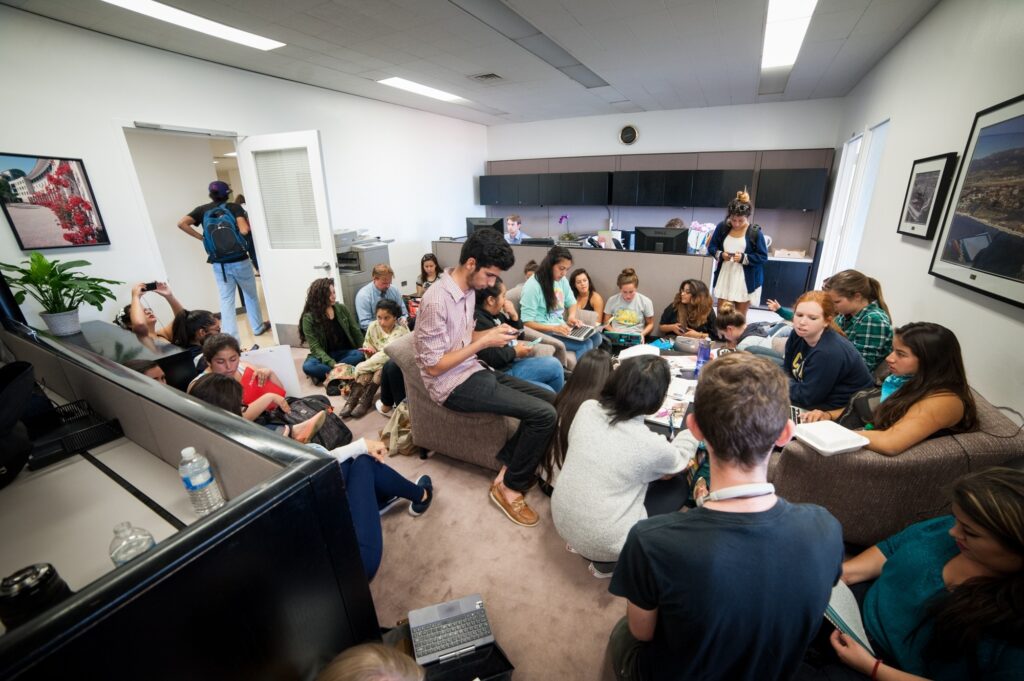A meeting on Wednesday discussed the recent changes to the UC’s sexual violence policies and how they may increase access to adequate support systems for victims of assualt

Previously, UCSB students held a sit-in to establish a more concrete policy in regard to sexual violence procedures and policies. Though this policy has been implemented and revised, a meeting was held on Wednesday to consider how recent changes will affect the student body and student access to support programs. Nexus File Photo
Students, staff and administrators met in the UCen’s Santa Barbara Harbor Room on Wednesday to discuss recent changes to how UCSB will respond to reports of sexual violence.
The group focused on evaluating the recently implemented UC-wide Sexual Violence and Sexual Harassment Policy and how it will affect UCSB students.
Senior Associate Dean of Student Life Debbie Fleming began the discussion by explaining the purpose of the meeting.
“Our goal from the staff side of things is just to make sure that we have an opportunity for regular communication, that we have an opportunity to sit down and hear from you about your ideas and thoughts on things, if there are concerns you think we need to beware of,” Fleming said.
Fleming said under UC policy, each campus has some freedom to determine implementation procedures.
“That is actually something we have more control over are our own campus procedures, so we can go back, look at that and amend that,” Fleming said. “The policy is the policy for now. It has been embedded, system-wide it has been approved, it has been implemented as of Jan. 4, so we don’t have the ability to make any changes to the policy, but we do have the ability to make changes to the way we describe the implementation procedures, and we can clarify things that aren’t clear.”
Briana Conway, victim advocacy specialist for C.A.R.E. Advocate Office for Sexual and Gender Based Violence and Sexual Misconduct program at UCSB, said the policy is clear for reports of a student perpetrator, but other procedures need further specification.
“I think phase two of that and ongoing will be really fleshing out what are the procedures when any one party is a non-affiliate and how do we work through next steps and action items as far as recording for that,” Conway said.
Timothy Irvine, vice president for Committees and Planning of the Graduate Students Association, said a flow chart for procedures on student reports could be useful.
“If that could be adopted here and accessible, but accessible without students having to go into C.A.R.E., so on a website or something, so if something has happened they don’t necessarily have to go in and consult with someone to get clarity on what the process might look like. I think that would be great,” Irvine said.
Irvine said websites explaining the procedures can potentially be difficult to navigate.
“Certainly if you know how to navigate these things, you can find what to do depending on what your situation is, and if you go to C.A.R.E., it is really easy to report and call C.A.R.E. and go into C.A.R.E., but that is not necessarily what everyone wants to do.”
Suzanne Perkin, assistant dean for student life at the Office of Judicial Affairs, said the C.A.R.E. Advocate Office is preparing a one-page document to distribute to students.
“We are working on a summary and overview one-page document on this process, so that is something that could just be handed out,” Perkin said. “Then we were thinking about, on the back, putting the flow chart.”
Conway said there should be a balance of transparency and privacy in the reporting and advocacy processes.
“What is that happy medium? We can put it all out there for transparency, and, yes, I fully support that. But I don‘t want it to ever lose the beautiful bond that an advocate can provide and help a survivor navigate their options,” Conway said. “That is the core value of why I wake up every morning.”
A version of this story appeared on p. 3 of the Thursday, February 4, 2016 edition of the Daily Nexus.
















Putting feminist ‘rape culture’ bigots in charge of stopping sexual ‘violence’ (most rapes involve no violence at all) is a pitiful approach to an imaginary crisis manufactured by those same ‘gendered’ bigots in the first place.
I’m not sure anyone in that room is having sex, consensual or not